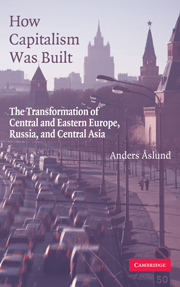Book contents
- Frontmatter
- Contents
- List of Tables and Figures
- List of Abbreviations
- Acknowledgments
- Introduction: A World Transformed
- 1 Communism and Its Demise
- 2 Shock Therapy versus Gradualism
- 3 Output: Slump and Recovery
- 4 Liberalization: The Creation of a Market Economy
- 5 From Hyperinflation to Financial Stability
- 6 Privatization: The Establishment of Private Property Rights
- 7 An Inefficient Social System
- 8 Democracy versus Authoritarianism
- 9 From Crime toward Law
- 10 The Role of Oligarchs
- 11 The Impact of the Outside World
- Conclusions: A World Transformed
- Bibliography
- Index
2 - Shock Therapy versus Gradualism
Published online by Cambridge University Press: 05 September 2012
- Frontmatter
- Contents
- List of Tables and Figures
- List of Abbreviations
- Acknowledgments
- Introduction: A World Transformed
- 1 Communism and Its Demise
- 2 Shock Therapy versus Gradualism
- 3 Output: Slump and Recovery
- 4 Liberalization: The Creation of a Market Economy
- 5 From Hyperinflation to Financial Stability
- 6 Privatization: The Establishment of Private Property Rights
- 7 An Inefficient Social System
- 8 Democracy versus Authoritarianism
- 9 From Crime toward Law
- 10 The Role of Oligarchs
- 11 The Impact of the Outside World
- Conclusions: A World Transformed
- Bibliography
- Index
Summary
The end of communism in Europe was the event of a lifetime. Suddenly twenty-eight countries with 400 million people had to choose their political and economic systems anew. Where should they begin? What was most important? What was possible? What theory should be applied? What policy corresponded to their interests? A frequent point was that no book prescribed how to transition from socialism to capitalism, whereas hundreds elaborated on the opposite, no longer desired, direction. A popular joke compared the transition from communism to capitalism to making an aquarium out of a fish soup.
The discussion became heated from the outset because so much was at stake. The fate of a large part of the world was up in the air. Could and should the former Soviet bloc be embraced by the Western world, or should it be shunned? Could armed conflicts be avoided? How much economic and social hardship would people in these countries have to suffer? Which ideology would win?
Intellectuals of all disciplines and convictions, governments, and international organizations geared up to answer the many questions. Although no clear goal was defined, a strong sense of direction prevailed. The popular battle cry was, “We want a ‘normal’ society!” By “normal,” people in the Soviet bloc meant an ordinary Western society – a democracy with a market economy, predominant private property, and the rule of law.
- Type
- Chapter
- Information
- How Capitalism Was BuiltThe Transformation of Central and Eastern Europe, Russia, and Central Asia, pp. 29 - 56Publisher: Cambridge University PressPrint publication year: 2007
- 1
- Cited by



